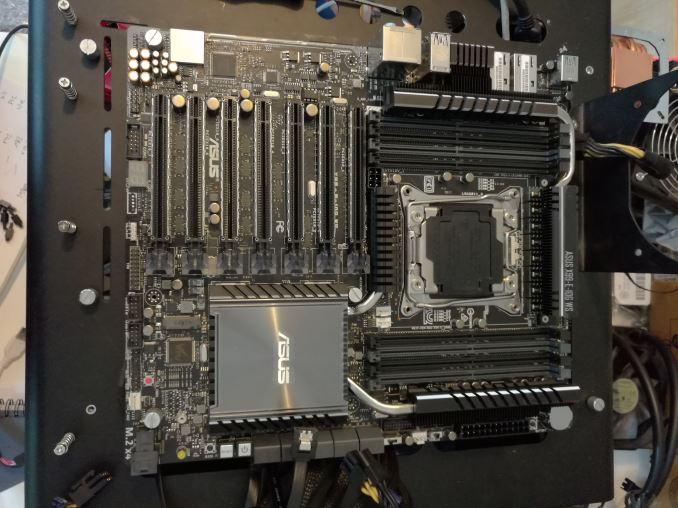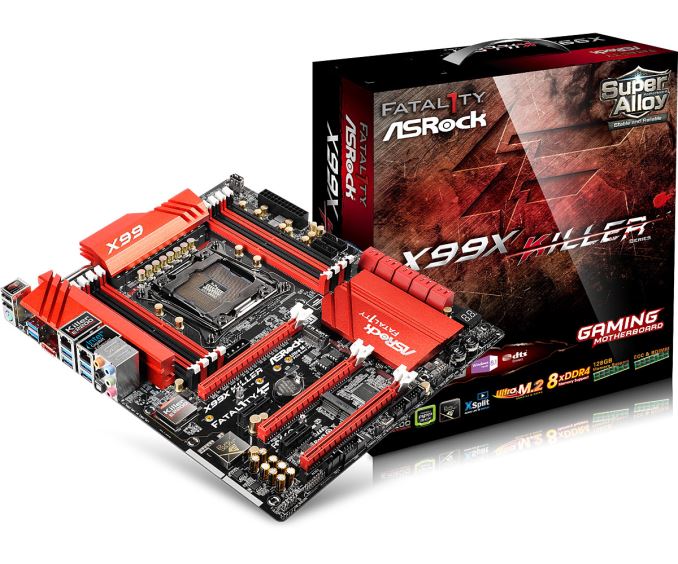The Intel Broadwell-E Review: Core i7-6950X, i7-6900K, i7-6850K and i7-6800K Tested
by Ian Cutress on May 31, 2016 2:01 AM EST- Posted in
- CPUs
- Intel
- Enterprise
- Prosumer
- X99
- 14nm
- Broadwell-E
- HEDT
The Market
At this point in time, Intel is primarily competing with itself. Because the enterprise market requires consistency, the HEDT platform is constrained to that three year, two product cycle, which maintains enough consistency in socket compatibility to keep the enterprise partners happy. When Intel has 95%+ of the HEDT and x86 enterprise market, rather than increasing market share to generate revenue, Intel has to convince users on older systems that their new products are worth the investment. That’s an easy sell in the enterprise market, as time is money and total cost of ownership for a system is typically well documented for cyclical updates.
For HEDT, making that case to prosumers can be difficult. It depends on budgets and how applications are developing, especially when a number of popular professional software packages are (where possible) trying to leverage PCIe accelerators. There will always be a strong market for CPU performance, and there will always be a market for HEDT, depending on the price. But at some point the HEDT and Xeon markets do collide, and the two main factors on this are price and availability.
As mentioned earlier, the newly introduced Broadwell-E Core i7 parts collide in price with a number of Broadwell-EP Xeon parts, which could suggest that Intel wants to push potential prosumers (especially the professional ones) more into systems made by enterprise and workstation partners. These systems are typically sold with appropriate support, and the two platforms differ by a few features. The question becomes about who is buying HEDT: a number of users reading this will be gamers, and will not be interested in workstation sellers.
It’s a strange balance that Intel is trying to strike. Everyone wants more – whether they need it or not is a different conversation – but most enthusiasts say they want more. Intel states that as a company, it supports the gamers and the enthusiasts who want to push their consumer platforms to the fullest, and something like Broadwell-E does that. However a prohibitive price might reduce the potential number of next generation enthusiasts who want to play at the high-end.
X99 Refresh Motherboards
Throughout this month many of the regular motherboard manufacturers have either released, announced, or teased newer "refresh" motherboards using the LGA2011-3 socket and the X99 chipset. We’ve got a base roundup of all the new motherboards coming out of Computex planned, especially as new models are being announced and shown at the show. A couple of these landed on our desk for Broadwell-E testing, such as the MSI X99A Gaming Pro Carbon:
The Carbon is a relatively new brand for MSI’s motherboard range, typically on the high-end models, and this one aims for a deep black aesthetic that is enhanced through the additional LED lighting.
We also have in the ASUS X99-E-10G WS motherboard, ASUS’ high-end workstation and prosumer based motherboard that also integrates an Intel X550-T2 10 gigabit Ethernet chip offering two 10GBase-T ports. We’ve seen this before on the ASRock X99 WS-E/10G, which used the X540-T2, and required eight PCIe 3.0 lanes from the CPU to provide enough bandwidth. We were only able to test the ASUS 10G board for a couple of days before leaving for Computex, and will have a preview up shortly.
ASRock also sent us their X99X Killer, although the courier tried to deliver on a day where I spent 30 minutes gathering stuff for the Computex trip. Go figure. It’ll be ready to test when I get back!
This Review
As with every CPU launch, there are a number of different directions to take our review. In our review of the launch of the consumer Broadwell parts, the i7-5775C and the i5-5675C we examined the generational update over previous architectures, and thus won’t repeat those tests here. We have had almost every high-end desktop CPU since Sandy Bridge-E in-house at some point, although only the latest have been through our most recent benchmark suite. Due to timing, we were able to test all four of the new Broadwell-E processors, and retest the three Haswell-E processors, however we have a more limited dataset for comparison to Ivy Bridge-E, Sandy Bridge-E and Nehalem/Westmere. It will be interesting to see how the CPU performance for the HEDT has adjusted over the last five generations.
The other angle is the recent release of Intel’s Skylake mainstream focused processors, such as the i7-6700K and the i5-6600K, which feature a higher single core frequency but fewer cores and fewer memory channels, or the mainstream enthusiast focused Devil’s Canyon processors released back in July 2014. These have been tested on our latest range of benchmarks, and should make it clear where the latest mainstream-to-HEDT crossover should be.
Test Setup
| Test Setup | |
| Processor | Intel Core i7-6950X (10C/20T, 3.0-3.5 GHz) Intel Core i7-6900K (8C/16T, 3.2-3.7 GHz) Intel Core i7-6850K (6C/12T, 3.6-3.8 GHz) Intel Core i7-6800K (6C/12T, 3.4-3.6 GHz, 28 PCIe 3.0) |
| Motherboards | MSI X99A Gaming Pro Carbon |
| Cooling | Cooler Master Nepton 140XL |
| Power Supply | OCZ 1250W Gold ZX Series Corsair AX1200i Platinum PSU |
| Memory | G.Skill RipjawsX DDR4-2400 C15 4x16GB 1.2V |
| Memory Settings | JEDEC @ 2400 |
| Video Cards | ASUS GTX 980 Strix 4GB MSI R9 290X Gaming 4G MSI GTX 770 Lightning 2GB MSI R9 285 Gaming 2G ASUS R7 240 2GB |
| Hard Drive | Crucial MX200 1TB |
| Optical Drive | LG GH22NS50 |
| Case | Open Test Bed |
| Operating System | Windows 7 64-bit SP1 |
Many thanks to...
We must thank the following companies for kindly providing hardware for our test bed:
Thank you to AMD for providing us with the R9 290X 4GB GPUs.
Thank you to ASUS for providing us with GTX 980 Strix GPUs and the R7 240 DDR3 GPU.
Thank you to ASRock and ASUS for providing us with some IO testing kit.
Thank you to Cooler Master for providing us with Nepton 140XL CLCs.
Thank you to Corsair for providing us with an AX1200i PSU.
Thank you to Crucial for providing us with MX200 SSDs.
Thank you to G.Skill and Corsair for providing us with memory.
Thank you to MSI for providing us with the GTX 770 Lightning GPUs.
Thank you to OCZ for providing us with PSUs.
Thank you to Rosewill for providing us with PSUs and RK-9100 keyboards.













205 Comments
View All Comments
hoohoo - Tuesday, May 31, 2016 - link
Single thread performance lower than previous generation, but more cores. Sadly the price is totally out of line.I want to upgrade from an i7-3820, these things do offer the bang but the buck is definitely missing.
hoohoo - Tuesday, May 31, 2016 - link
Shouldn't they be using their GTX 1080? The games do not seem to be CPU bound. Am I reading the charts wrong?pavag - Tuesday, May 31, 2016 - link
"For $1721, [...] can invest in either the 14-core E5-2680 v4 [...] or get double the cores in a 2P system and using the E5-2640 v4 processor: a 10-core 2.4 GHz/3.4 "Ok. You said it, you own it.
Do the benchmarks and compare. I actually need it.
Seekmore - Wednesday, June 1, 2016 - link
Intel I7 6950x-Like it already? It is overpriced and is the most expensive in the history of processors till the date. An excellent Processor with excellent performance calculated for its price and features it supports. One of the fastest processor ranking high in the category.http://www.comparecpus.com/en/intel-i7-5960x-vs-am...
Get other details of Intel I7 6950x Extreme Edition to find out why is everybody looking for it..
Spunjji - Wednesday, June 1, 2016 - link
I saw the prices and threw up a little in my mouth. This is market capitalism at its nadir :(Spunjji - Wednesday, June 1, 2016 - link
...specifically with respect to the tech industry, obviously - didn't to be that hyperbolic.stimudent - Wednesday, June 1, 2016 - link
I just need to do my banking and watch porn. 56 cores should do the trick.Gothmoth - Thursday, June 2, 2016 - link
multitasking is the word.i use lightroom, photoshop, autopano giga at the same time very often.. every core helps.
or i render out a video with premiere while i edit a composition in after effects.
iGigaflop - Thursday, June 2, 2016 - link
I'll keep my 5820k i was kicking myself for not waiting 2 months for the 6800k but broadwell might be a little faster per clock but it doesnt overclock as good as haswell. I run my 5820k at 4.7 at 1.313 volts i think mine in a great overclocker and it never goes above mid 70c. But for everyday use i keep it at 4.2 and it stays around 50c. Im using a h100v2 and a cm storm stryker case. I think pretty much every 5820k should go 4.3-4.5ghz. And im running it off a asus x99 deluxe board. I just hope they keep the x99 v3 socket for skylake e.Jackie60 - Friday, June 3, 2016 - link
Why do you bother with the pointless GPU limited benchmarks-it's a total waste of time and effort and tell us nothing.